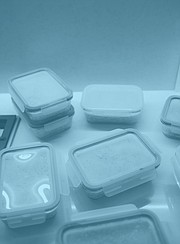By Dr Selima Hauber
of One Eleuthera Foundation
THE Joneses – what a model family! They are in the prime of their lives and have satisfying careers that pay well. Their 2.5 children are healthy and do well in school and extracurricular activities. Their comfortable home is in a safe neighbourhood, surrounded by other families with similarly aged children who often play together. Healthcare is covered by insurance, and they carry very little debt. The Jones family would appear to have all their ducks in a row, but they have a deep, dark secret – they are slowly poisoning their beloved children – and themselves, for that matter. Like most modern families, they are entirely unaware of the sea of pollutants they are submerged in every day. Consumer products commonly contain a slew of chemicals that may cause a range of health effects, including asthma, endocrine disruption, reproductive and developmental harm, and cancer.
Before we follow the Jones family on a typical day to expose the unknown dangers, let us consider a recently published study by the Silent Spring Institute and the University of California Berkeley. The study revealed that “more than 5,000 tons of toxic chemicals (are) released from consumer products every year inside homes and workplaces”. Looking at volatile organic compounds that are known to the state of California as carcinogens, reproductive toxicants, and, or developmental toxicants, the researchers identified thirty consumer product categories as immediate priorities for restricting use or for product reformulation using safer ingredients. As valuable as the findings of this study are, it is incomplete as it does not consider product ingredients associated with causing asthma, neurotoxicity and endocrine disruptions. Endocrine disruptors are chemicals commonly included in consumer products that mimic or interfere with our natural hormones. These impacts can result in health disorders such as increased cancer risks, diabetes, asthma, obesity, male and female infertility and attention and behavioral disorders in children.
On a bright Monday morning, Mrs Jones awakes and saunters off to the bathroom for a shower using her favorite fruity-smelling body wash. The rest of the family soon get up, and in half an hour, they are out the door on their way to work and school.
Personal care products, such as toothpaste and body wash, are some of the worst offending products, containing numerous volatile organic compounds and the endocrine disruptors: parabens and phthalates. Parabens have been shown to stimulate breast cancer cell growth. In separate studies, phthalates were found to be associated with female fertility disorders, early puberty and changes in male hormone and semen levels.
Lunchtime finds the Jones family at work and school enjoying last night’s leftovers neatly packed by Mrs Jones in plastic storage containers with a heart and smiley face emoji on a sticky note. The kids wash lunch down with their favorite juice drink from a plastic bottle that fits perfectly in their insulated lunch bags. Unfortunately, the plastic containers and bottles are either labeled “PC” (polycarbonate) or are in the recycling category 7, which are plastic types that contain bisphenols. Bisphenols are endocrine disruptors associated with male and female infertility, early puberty and hormone-dependent cancers like breast and prostate cancer. Bisphenols are also used in the linings of some canned foods.
At the end of the workday, Mr Jones realises he must stop for gas before picking up the rest of his family. He opens the window to tell the pump attendant how much gas he needs and passes the time checking his WhatsApp messages. Before long, he is off again and grabs Mrs. Jones from work and the kids from school.
By leaving his car window open while fueling up, Mr Jones has inadvertently exposed himself to the volatile benzenes in the gas. Benzene is a carcinogen that has been linked to several types of blood cancer. To reduce his exposure, Mr Jones should have remained upwind of the pump and kept his window closed.
On the way home, Mrs Jones stops quickly at the food store for ingredients for dinner. She pays with her debit card and grabs the receipts from the cashier. Debit and credit card receipt paper is often thermal paper, which contains bisphenols that can be absorbed through the skin. In addition to the aforementioned effects, bisphenols are also obesogens. These chemicals alter appetite, metabolic rate or energy balance, which can directly or indirectly increase body fat and promote obesity.
Upon arriving home, the parents are not-so-pleasantly surprised by the grass and mud stains the kids have picked up while enjoying an active day at school. Mrs. Jones immediately launders the soiled uniforms using extra detergent before sending the children for a bath before dinner. Meanwhile, Mr Jones is busy in the garden, taking care of pesky weeds and unwanted bugs by applying pesticide dust and weed killer.
Laundry detergents are one of the consumer product classes prioritized for use restriction or reformulation because of their high content of carcinogenic chemicals and others that cause reproductive and developmental toxicity. Laundry detergents also contain phthalates, the endocrine disruptors. These chemicals are added to make detergent fragrances persist in the laundry for weeks after being washed. Lawn and garden care products can be another highly toxic and dangerous category. The chemicals contained can have a detrimental effect on human health. Besides killing insect pests, they also harm the beneficial insects that protect crops.
Mr Jones then goes to the bathroom to hurry the kids to the dinner table. Stopping short of the muddy prints all over the bathroom, he grabs the all-purpose spray cleaner from beneath the sink and quickly removes the evidence of the kids’ bathroom escapades. After dinner, the kids head off to bed and Mr. Jones cleans the kitchen. Mrs. Jones retires to the living room. She puts her feet up waiting for Mr. Jones to return with two cups of Chamomile tea that they will sip while reconnecting after a hectic day. It is her favorite room in the house. She relished choosing the furniture, mood lighting and even the pricey, aromatic room fragrance but never recognized the dangers disguised in these purchases.
All-purpose cleaners, dishwashing liquid and air fresheners are all top offenders for containing numerous toxic volatile organic compounds. Furniture is often also a source of harmful flame-retardant chemicals and other chemicals that allow its surfaces to repel water and stains. Flame retardant chemicals impact the immune system, change neurologic function, and adversely affect fetal and child development. Additionally, water and stain-repellant chemicals increase asthma risks and cause changes in liver enzymes, amongst other harmful effects.
Modern-day life with all its conveniences can place our health under constant assault from the thousands of toxic chemicals in various everyday consumer products. The health effects that come from daily exposure to these toxic chemicals occur over time as the different chemicals and health effects accumulate. One of the most common health issues linked to toxic chemicals is cancer. The good news is that many of these chemicals can be cleared from our bodies within days of stopping the exposure. You can begin to reduce your family’s risk by thoroughly auditing the products you use and swapping the offending ones for safer alternatives. Here is how you can start:
• Avoid paper credit/debit card receipts
• Avoid personal care products, laundry and household cleaning detergents with strong perfumes or fragrances. Choose ‘fragrance-free’ or ‘hypoallergenic’ options.
• Avoid non-stick pots and pans, plastic wrap and plastic food storage containers and store food in glass or stainless-steel containers.
• Avoid canned food as much as possible.
• Avoid waterproof cosmetics
• Choose furniture, mattresses and pillows that don’t contain flame retardants or are water and stain-repellant.







Comments
hrysippus 7 months, 2 weeks ago
Brilliant. Valuable information which will sadly reach too few. And I am someone who has used Dr. Bonners pure castile soap exclusively for about 50 years now.
Sign in to comment
Or login with:
OpenID